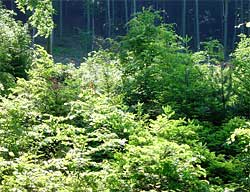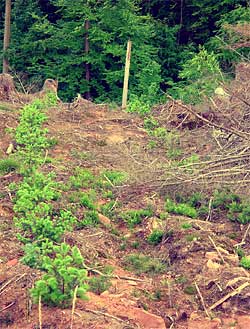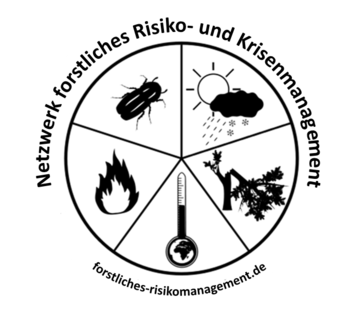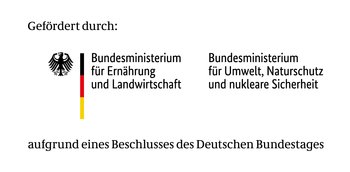Objectives
Natural regeneration
A natural regeneration of storm damaged areas should be aspired to wherever reasonable and possible.
- Take time! Many areas require a number of years to reach a site adapted afforestation condition.
- Attention! This does not apply to nutritious sites, where a fast growing, competing vegetation (e.g. blackberry, Rubus fructicosus) is expected.
- Any possibility to increase the proportion of naturally regenerating, site adapted, light-demanding tree species at storm damaged sites should be used.
- Stock, that is not suited to the site or whose quality is unsatisfactory, must be gradually removed (e.g. natural regeneration of spruce on periodically wet sites).
- The domination of deciduous tree species on regeneration areas, especially ash and maple, is a succession phase in many forest ecosystems. Therefore, stocking down these species is not necessary.

Natural regeneration of beech.
(Photo: Forstbilddatenbank BW)
Ground clearing
Generally it's not necessary to remove slash from the site (crowns, brushwood or non-marketable assortments).Unless the entire regeneration is influenced by slash. In that case spot treatment is sufficient.
Machines supported by cranes have proved useful during slash removal. However, they are only permitted to drive on skid roads.
Mechanical removal from the entire site is to be avoided for financial reasons as well as the irreversible soil damage it causes.
Retaining slash offers some advantages:
- Cost savings
- Wind calming and shadowing effects
- Prevention from competing flora
- Obstacles for game
Furthermore on-site slash makes the use of larger plants, and hence an adjusted planting method and intensive site preparation unnecessary. Burning or chipping of slash for forest protection reasons should be limited to exceptional circumstances.
Cultivation and seeding

Spruce plantation.
(Photo: Forstbilddatenbank BW)
Active measures of plantation establishment should be restricted to the absolute minimum. Due to the expected shortage of plants and for financial reasons, planting with a small number of plants is preferred.
- Active measures of plantation establishment are generally necessary for areas > 0,3 ha.
- No plantation of oak over the entire site (this possibly also applies for hardwoods), rather plant oak clusters. The number of clusters should relate to the number of future crop trees. Where site adapted associate tree species exist or are expected, it is possible to plant a small number of plants in rows (e.g. with an excavator).
- Plantation of coniferous trees: small number of plants and broad tree spacings.
- Use only high-quality plant stock from suitable provenances. If necessary wait until the market offers suitable material. An exploratory meeting with representatives of the forest tree nursery branch and members of the forest administration can clarify the situation and the availability of plant stock in advance.
- It is preferable to use large assortments and careful planting methods, especially on nutritious sites, which are at risk of weed infestation, as well as on skeletal poor sites.
Seeding is especially suitable for the artificial establishment of pioneer crops. An exception is the seeding of main tree species instead of via plantation. The processing of storm damaged timber and the subsequent skidding, results in the necessary soil wounding for seeding.
Selection of tree species
The selection of tree species for afforestation of storm damaged areas has to be in accordance with country-/state-specific requirements (in Baden-Wuerttemberg for example with national/regional forest development types).
After a storm event, the forest administration management should inform afforesters about the selection of suitable tree species and the type of afforestation as well as the desired long term composition of tree species. Depending on the quantity and type of damage, as well as the composition of the affected tree species, adjustments to regulations are necessary.
It’s helpful to provide a map of site conditions (if available) as well as planning and target stocking maps (if available) for planning and conceptualising the afforestation.
Forest enterprises, which were seriously affected by "Lothar", received a new forest management plan. A so called "afforestation plan" was developed for enterprises with considerable damages.
Planting method
Large plant assortments require careful planting methods. Angle planting becomes less important then semicircular spade or excavator planting.
Important: At planting pay careful attention to the rootball. The selected planting method depends on the size and shape of the root as well as the site conditions.
For soil protection reasons, mechanical planting methods are only to be performed from skid roads. The utilisation of a planting auger, which is mounted to a tractor, has to be discarded to avoid driving across the entire area.
Additional costs for more extensive planting methods will be more than compensated by using less plants as well as waiving ground clearance and plant protection measures.
Plant protection and browsing
Using larger plants (minimum 80/120 cm height) makes plant protection measures unnecessary and avoids the need for certain expensive measures (deer repellent etc.). It's more important to establish hunting grounds next to afforested storm areas. Only careful planting guarantees the successful initial survival of large plants and reduces the need for later interplanting.
Ecology and recreation
Due to storms, large cleared areas and open stands offer light- and warm loving plants and animals survival opportunities they wouldn't normally find in the climax forest communities of semi-natural, managed forests. Furthermore the increased proportion of dead trees (coarse woody debris), enlarges the range of habitats for rare species.
The protection and support of these rare species has to be taken into consideration during afforestation.
Aspects of recreation and landscape, e.g. maintenance of viewpoints, must also be considered during afforestation.
Silvicultural concept of afforestation after "Lothar" in Baden-Wuerttemberg - a short overview
The following silvicultural conception of afforestation was developed in accordance with existing natural regeneration and available source-identified plant material after "Lothar" in Baden-Wuerttemberg:
| Principle | Explanation |
| Semi-natural silviculture | Objective: Establishment and cultivation of stable single trees. |
| Natural regeneration | Natural regeneration of storm areas is preferred where possible and reasonable. |
| Take time | On many storm damaged areas it is possible to establish site adapted regeneration later on. |
| Extensive ground clearing | Basically it’s not necessary to remove slash from the entire site. |
| Cultivation and seeding |
|
| Selection of tree species | Basis for the selection of tree species is the forest site map. The chance to increase the share of light demanding species (sycamore maple, ash, pine) on storm damaged areas should be taken. Suitable sites can be used to establish spruce or Douglas fir as mixed tree species. Plantation of shade-tolerant trees such as beech or silver fir should be avoided on open sites. Birch, mountain ash and alder have particular importance as pioneer crop species. Other rare tree species, especially light demanding species (cherry-tree, wild fruit, walnut, sorbus-species), should to be established on open sites wherever possible |
| Adjusted planting methods | Quality and suitability of the planting method influences the initial survival of the plant. |
| Protection against browsing, interplanting, protection of seedling stage | Careful planting methods and the consideration of natural processes of self-differentiation in natural regeneration, avoids the need for protection measures during the seedling stage and against browsing as well as interplanting in many cases. |
| Ecology and recreation | Large cleared areas and open stands are the result of storms in Baden-Wuerttemberg. These sites offer light- and warm loving plants and animals unique growing opportunities, and their protection and support must be taken into consideration during afforestation. |
Forest Crises Management Advisory Guide
Back to the main page of the Forestry Crisis Management Advisor Guide: Overview of the different topic collections
Back to the article overview in the: Storm Topic Collection – Coping with Storm Damaged Timber


